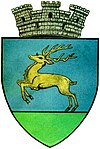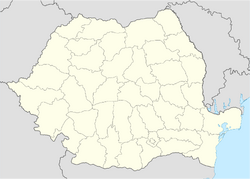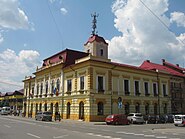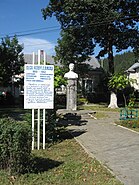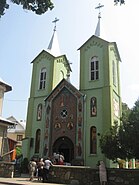| Main | Births etc |
|---|
| Gura Humorului | |||
|---|---|---|---|
| — Town — | |||
| Gura Humorului Town Hall | |||
|
|||
| Coordinates: Coordinates: | |||
| Country | |||
| County | |||
| Status | Town | ||
| Government | |||
| • Mayor | Marius Ioan Ursaciuc (Social-Liberal Union) | ||
| Area | |||
| • Total | 60.90 km2 (23.51 sq mi) | ||
| Population (2011 census)[1] | |||
| • Total | |||
| • Density | 209/km2 (540/sq mi) | ||
| Time zone | EET (UTC+2) | ||
| • Summer (DST) | EEST (UTC+3) | ||
| Website | Official site | ||
Gura Humorului (Hebrew and Yiddish: גורה חומורולוי - Gur’ Humuruluei or גורה הומורה - Gur' Humura; German and Polish: Gura Humora) is a town in Suceava County, north-eastern Romania. It is situated in the historical region of Bukovina. Gura Humorului is the seventh largest urban settlement in the county, with a population of 12,729 inhabitants, according to the 2011 census. It was declared a town in 1904 and it became a resort in 2005. The town administers the former village of Voroneț (which became a neighborhood), site of the Voroneț Monastery.
Geography[]
Gura Humorului is located in the north-eastern part of Romania, in southern Bukovina. The town is situated at the eastern limit of Obicinele Bucovinei mountains, in Humorului Depression, at the confluence of Moldova River and Humor River. The average altitude of the town is 470 meters. The European route E58 and the Suceava - Vatra Dornei railway pass through the town. Suceava, the county capital, is located 34 km away. The town of Frasin is located nearby Gura Humorului (only 7 km away).
Demographics[]
According to the 1775 Austrian Bukovina census, its population comprised only about 60,000 spread over 10,422 square kilometers. In order to encourage the development of this sparsely-settled land, the authorities subsidized the immigration of colonists to Bukovina. With the end of the first wave of settlement, colonists were to continue arriving at their own expense. As a result of these policies, the census of 1910 showed that the population had risen to over 800,000. People of many different ethnic groups took part in this immigration, including Germans, Rusyns, Hungarians, Ukrainians, Poles, Romanians, and Jews.
| Historical population | ||
|---|---|---|
| Year | Pop. | ±% |
| 1910 | 5,308 | — |
| 1930 | 6,042 | +13.8% |
| 1948 | 4,573 | −24.3% |
| 1956 | 7,216 | +57.8% |
| 1966 | 9,081 | +25.8% |
| 1977 | 13,235 | +45.7% |
| 1992 | 16,629 | +25.6% |
| 2002 | 15,656 | −5.9% |
| 2011 | 12,729 | −18.7% |
| Source: Census data | ||
Gura Humorului reached its peak population in 1992, when almost 17,000 people were living within the town limits.
According to the 2011 census data, Gura Humorului had a total population of 12,729 inhabitants: 97.03% were ethnic Romanians, 1.79% Gypsies, 0.52% Germans, 0.27% Poles, 0.12% Ukrainians, 0.10% Hungarians and 0.07% Russians and Lipovans.
Gura Humorului is the seventh most populated urban locality in Suceava County and the second most populated locality with the status of town (after Vicovu de Sus).
History[]
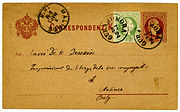
Austrian KK postal card mailed from Gurahumora in 1878
Until 1918, Gura Humorului belonged to the Austrian monarchy (in the Austrian part of the empire after the compromise of 1867), in the district of the same name, one of the 9 Bezirkshauptmannschaften in Bukovina province.[2]
During World War I, Bukovina became a battlefield between Austrian and Imperial Russian troops. Although the Russians were finally driven out in 1917, defeated Austria would cede the Bukovina province to Romania through the Treaty of Saint-Germain (1919).
Twin towns – Sister cities[]
 Marly-le-Roi, France
Marly-le-Roi, France
Natives[]
- Nathan H. Juran - American film art director
- Olha Kobylianska - Ukrainian writer
- Rixi Markus - bridge player
- Cătălin Ţăranu - professional go player (5 Dan)
- Salomon Wininger - biographer
Gallery[]
References[]
- ^ "Suceava County at the 2011 census" (in Romanian). INSSE. February 2, 2012. http://www.suceava.insse.ro/phpfiles/Comunicat%20-%20pt%20site-DATE%20PROVIZORII%20RPL%202011%202_Suceava.pdf. Retrieved March 12, 2012.
- ^ Die postalischen Abstempelungen auf den österreichischen Postwertzeichen-Ausgaben 1867, 1883 und 1890, Wilhelm Klein, 1967.
External links[]
| Wikivoyage has a travel guide for Gura Humorului. |
- (Romanian) Gura Humorului Town Hall official site
- (Romanian) Gura Humorului touristic site
- (Romanian) Gura Humorului unofficial site
- (Romanian) Tourism Guide - Gura Humorului web page
- (Romanian) Suceava County site - Gura Humorului web page
- (Romanian) Photo Gallery - Old photos of Gura Humorului
- (Hebrew) Gura Humorului Jewish Community
- (Hebrew) Comprehensive lists of Gura Humorului Jews killed in 1941
| |||||

|
Mănăstirea Humorului | Pârteștii de Jos | Păltinoasa | 
|
| Frasin | Capu Câmpului | |||
 Gura Humorului | ||||
| Slatina | Valea Moldovei |

